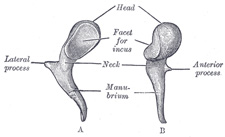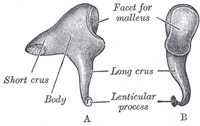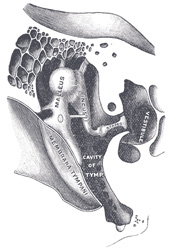(Ossicula Auditus)
The tympanic cavity contains a chain of three movable ossicles, the malleus, incus, and stapes. The first is attached to the tympanic membrane, the last to the circumference of the fenestra vestibuli, the incus being placed between and connected to both by delicate articulations. | 1 |
| The Malleus (Fig. 916), so named from its fancied resemblance to a hammer, consists of a head, neck, and three processes, viz., the manubrium, the anterior and lateral processes. | 2 |
| The head (capitulum mallei) is the large upper extremity of the bone; it is oval in shape, and articulates posteriorly with the incus, being free in the rest of its extent. The facet for articulation with the incus is constricted near the middle, and consists of an upper larger and lower smaller part, which form nearly a right angle with each other. Opposite the constriction the lower margin of the facet projects in the form of a process, the cog-tooth or spur of the malleus. | 3 |
 |
FIG. 916– Left malleus. A. From behind. B. From within. (See enlarged image) |
| |
| The neck (collum mallei) is the narrow contracted part just beneath the head; below it, is a a prominence, to which the various processes are attached. | 4 |
| The manubrium mallei (handle) is connected by its lateral margin with the tympanic membrane. It is directed downward, medialward, and backward; it decreases in size toward its free end, which is curved slightly forward, and flattened transversely. On its medial side, near its upper end, is a slight projection, into which the tendon of the Tensor tympani is inserted. | 5 |
| The anterior process (processus anterior [Folii]; processus gracilis) is a delicate spicule, which springs from the eminence below the neck and is directed forward to the petrotympanic fissure, to which it is connected by ligamentous fibers. In the fetus this is the longest process of the malleus, and is in direct continuity with the cartilage of Meckel. | 6 |
| The lateral process (processus lateralis; processus brevis) is a slight conical projection, which springs from the root of the manubrium; it is directed laterally, and is attached to the upper part of the tympanic membrane and, by means of the anterior and posterior malleolar folds, to the extremities of the notch of Rivinus. | 7 |
| The Incus (Fig. 917) has received its name from its supposed resemblance to an anvil, but it is more like a premolar tooth, with two roots, which differ in length, and are widely separated from each other. It consists of a body and two crura. | 8 |
| The body (corpus incudis) is somewhat cubical but compressed transversely. On its anterior surface is a deeply concavo-convex facet, which articulates with the head of the malleus. | 9 |
| The two crura diverge from one another nearly at right angles. | 10 |
| The short crus (crus breve; short process), somewhat conical in shape, projects almost horizontally backward, and is attached to the fossa incudis, in the lower and back part of the epitympanic recess. | 11 |
| The long crus (crus longum; long process) descends nearly vertically behind and parallel to the manubrium of the malleus, and, bending medialward, ends in a rounded projection, the lenticular process, which is tipped with cartilage, and articulates with the head of the stapes. | 12 |
| The Stapes (Fig. 918), so called from its resemblance to a stirrup, consists of a head, neck, two crura, and a base. | 13 |
| The head (capitulum stapedis) presents a depression, which is covered by cartilage, and articulates with the lenticular process of the incus. | 14 |
| The neck, the constricted part of the bone succeeding the head, gives insertion to the tendon of the Stapedius muscle. | 15 |
| The two crura (crus anterius and crus posterius) diverge from the neck and are connected at their ends by a flattened oval plate, the base (basis stapedis), which forms the foot-plate of the stirrup and is fixed to the margin of the fenestra vestibuli by a ring of ligamentous fibers. Of the two crura the anterior is shorter and less curved than the posterior. | 16 |
 |
FIG. 917– Left incus. A. From within. B. From the front. (See enlarged image) |
| |
 |
FIG. 918– A. Left stapes. B. Base of stapes, medial surface. (See enlarged image) |
| |
| |
| Articulations of the Auditory Ossicles (articulationes ossiculorum auditus).—The incudomalleolar joint is a saddle-shaped diarthrosis; it is surrounded by an articular capsule, and the joint cavity is incompletely divided into two by a wedge-shaped articular disk or meniscus. The incudostapedial joint is an enarthrosis, surrounded by an articular capsule; some observers have described an articular disk or meniscus in this joint; others regard the joint as a syndesmosis. | 17 |
| |
| Ligaments of the Ossicles (ligamenta ossiculorum auditus).—The ossicles are connected with the walls of the tympanic cavity by ligaments: three for the malleus, and one each for the incus and stapes. | 18 |
| The anterior ligament of the malleus (lig. mallei anterius) is attached by one end to the neck of the malleus, just above the anterior process, and by the other to the anterior wall of the tympanic cavity, close to the petrotympanic fissure, some of its fibers being prolonged through the fissure to reach the spina angularis of the sphenoid. | 19 |
| The superior ligament of the malleus (lig. mallei superius) is a delicate, round bundle which descends from the roof of the epitympanic recess to the head of the malleus. | 20 |
| The lateral ligament of the malleus (lig. mallei laterale; external ligament of the malleus) is a triangular band passing from the posterior part of the notch of Rivinus to the head of the malleus. Helmholtz described the anterior ligament and the posterior part of the lateral ligament as forming together the axis ligament around which the malleus rotates. | 21 |
| The posterior ligament of the incus (lig. incudis posterius) is a short, thick band connecting the end of the short crus of the incus to the fossa incudis. | 22 |
| A superior ligament of the incus (lig. incudis superius) has been described, but it is little more than a fold of mucous membrane. | 23 |
| The vestibular surface and the circumference of the base of the stapes are covered with hyaline cartilage; that encircling the base is attached to the margin of the fenestra vestibuli by a fibrous ring, the annular ligament of the base of the stapes (lig. annulare baseos stapedis). | 24 |
| The Muscles of the Tympanic Cavity (musculi ossiculorum auditus) are the Tensor tympani and Stapedius. | 25 |
| The Tensor tympani, the larger, is contained in the bony canal above the osseous portion of the auditory tube, from which it is separated by the septum canalis musculotubarii. It arises from the cartilaginous portion of the auditory tube and the adjoining part of the great wing of the sphenoid, as well as from the osseous canal in which it is contained. Passing backward through the canal, it ends in a slender tendon which enters the tympanic cavity, makes a sharp bend around the extremity of the septum, and is inserted into the manubrium of the malleus, near its root. It is supplied by a branch of the mandibular nerve through the otic ganglion. | 26 |
 |
FIG. 919– Chain of ossicles and their ligaments, seen from the front in a vertical, transverse section of the tympanum. (Testut.) (See enlarged image) |
| |
| The Stapedius arises from the wall of a conical cavity, hollowed out of the interior of the pyramidal eminence; its tendon emerges from the orifice at the apex of the eminence, and, passing forward, is inserted into the posterior surface of the neck of the stapes. It is supplied by a branch of the facial nerve. | 27 |
| |
| Actions.—The Tensor tympani draws the tympanic membrane medialward, and thus increases its tension. The Stapedius pulls the head of the stapes backward and thus causes the base of the bone to rotate on a vertical axis drawn through its own center; the back part of the base is pressed inward toward the vestibule, while the forepart is withdrawn from it. By the action of the muscle the tension of the fluid within the internal ear is probably increased. | 28 |
| The Mucous Membrane of the Tympanic Cavity is continuous with that of the pharynx, through the auditory tube. It invests the auditory ossicles, and the muscles and nerves contained in the tympanic cavity; forms the medial layer of the tympanic membrane, and the lateral layer of the secondary tympanic membrane, and is reflected into the tympanic antrum and mastoid cells, which it lines throughout. It forms several vascular folds, which extend from the walls of the tympanic cavity of the ossicles; of these, one descends from the roof of the cavity to the head of the malleus and upper margin of the body of the incus, a second invests the Stapedius muscle: other folds invest the chorda tympani nerve and the Tensor tympani muscle. These folds separate off pouch-like cavities, and give the interior of the tympanum a somewhat honey-combed appearance. One of these pouches, the pouch of Prussak, is well-marked and lies between the neck of the malleus and the membrana flaccida. Two other recesses may be mentioned: they are formed by the mucous membrane which envelops the chorda tympani nerve and are situated, one in front of, and the other behind the manubrium of the malleus; they are named the anterior and posterior recesses of Troltsch. In the tympanic cavity this membrane is pale, thin, slightly vascular, and covered for the most part with columnar ciliated epithelium, but over the pyramidal eminence, ossicles, and tympanic membrane it possesses a flattened non-ciliated epithelium. In the tympanic antrum and mastoid cells its epithelium is also non-ciliated. In the osseous portion of the auditory tube the membrane is thin; but in the cartilaginous portion it is very thick, highly vascular, and provided with numerous mucous glands; the epithelium which lines the tube is columnar and ciliated. | 29 |
| |
| Vessels and Nerves.—The arteries are six in number. Two of them are larger than the others, viz., the tympanic branch of the internal maxillary, which supplies the tympanic membrane; and the stylomastoid branch of the posterior auricular, which supplies the back part of the tympanic cavity and mastoid cells. The smaller arteries are—the petrosal branch of the middle meningeal, which enters through the hiatus of the facial canal; a branch from the ascending pharyngeal, and another from the artery of the pterygoid canal, which accompany the auditory tube; and the tympanic branch from the internal carotid, given off in the carotid canal and perforating the thin anterior wall of the tympanic cavity. The veins terminate in the pterygoid plexus and the superior petrosal sinus. The nerves constitute the tympanic plexus, which ramifies upon the surface of the promontory. The plexus is formed by (1) the tympanic branch of the glossopharyngeal; (2) the caroticotympanic nerves; (3) the smaller superficial petrosal nerve; and (4) a branch which joins the greater superficial petrosal. | 30 |
| The tympanic branch of the glossopharyngeal (Jacobson’s nerve) enters the tympanic cavity by an aperture in its floor close to the labyrinthic wall, and divides into branches which ramify on the promontory and enter into the formation of the tympanic plexus. The superior and inferior caroticotympanic nerves from the carotid plexus of the sympathetic pass through the wall of the carotid canal, and join the branches of the tympanic branch of the glossopharyngeal. The branch to the greater superficial petrosal passes through an opening on the labyrinthic wall, in front of the fenestra vestibuli. The smaller superficial petrosal nerve, from the otic ganglion, passes backward through a foramen in the middle fossa of the base of the skull (sometimes through the foramen ovale), and enters the anterior surface of the petrous part of the temporal bone through a small aperture, situated lateral to the hiatus of the facial canal; it courses downward through the bone, past the genicular ganglion of the facial nerve, receiving a connecting filament from it, and enters the tympanic cavity, where it communicates with the tympanic branch of the glossopharyngeal, and assists in forming the tympanic plexus. | 31 |
| The branches of distribution of the tympanic plexus are supplied to the mucous membrane of the tympanic cavity; a branch passes to the fenestra vestibuli, another to the fenestra cochleæ, and a third to the auditory tube. The smaller superficial petrosal may be looked upon as the continuation of the tympanic branch of the glossopharyngeal through the plexus to the otic ganglion. | 32 |
| In addition to the tympanic plexus there are the nerves supplying the muscles. The Tensor tympani is supplied by a branch from the mandibular through the otic ganglion, and the Stapedius by a branch from the facial. | 33 |
| The chorda tympani nerve crosses the tympanic cavity. It is given off from the sensory part of the facial, about 6 mm. before the nerve emerges from the stylomastoid foramen. It runs from below upward and forward in a canal, and enters the tympanic cavity through the iter chordæ posterius, and becomes invested with mucous membrane. It traverses the tympanic cavity, crossing medial to the tympanic membrane and over the upper part of the manubrium of the malleus to the carotid wall, where it emerges through the iter chordæ anterius (canal of Huguier). | 34 |



